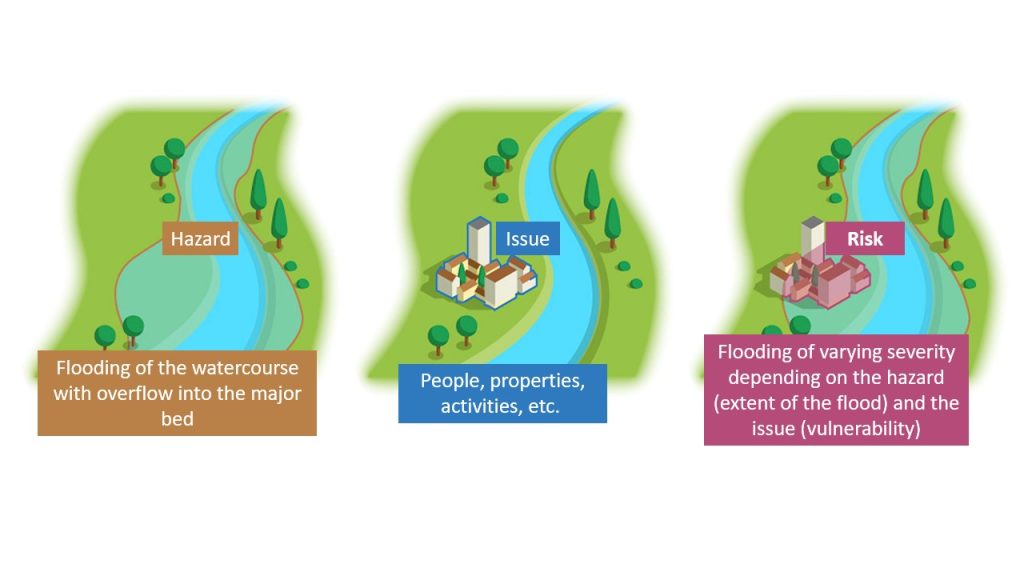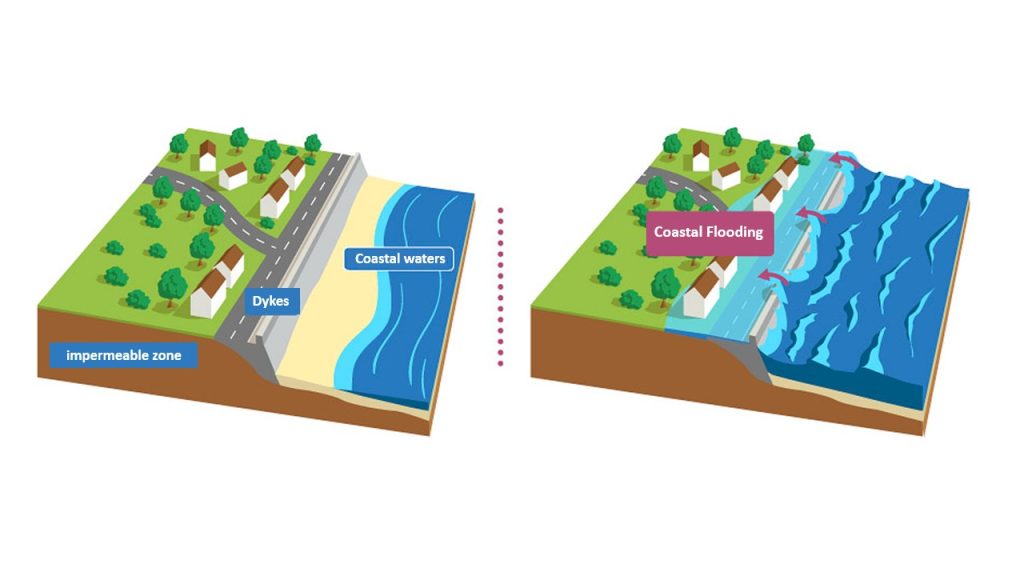Floods are hydrological events that occur when the water level in a land area exceeds its capacity to absorb water. This phenomenon can be caused by various factors, including excessive precipitation, snowmelt, storms, rising sea levels, dam breaches, or a combination of these elements. These hydro meteorological disturbances lead to the flooding of land, which can have serious consequences for ecosystems, property, and human lives.
1. Presentation of Different Types of Floods
There are several causes of flooding, and they can combine to aggravate the phenomena. In the context of Climate change, it can be difficult to attribute the exact cause. But let’s take a look at the main sources.
River Flooding
River floods result from a significant increase in the flow of a river. This increase is usually triggered by extreme weather events, such as heavy rainfall or snowmelt. River floods are more common in areas located near rivers because watersheds and floodplains are more exposed. This is the best-known and most frequent cause of flooding, and also the one that can be most easily located and this is the case for almost all our case studies.
Flash Flooding
Flash floods result from the breach of dams, dikes, or canals, leading to the sudden and massive release of stored water. While less frequent, when these infrastructures fail, they can cause sudden and devastating floods downstream.
Coastal Flooding
Coastal flooding occurs due to rising sea levels, often triggered by phenomena such as storms, hurricanes, or long-term variations in sea levels caused by Climate change. We see this type of floods in the Helsinki Metropolitan Area in Finland.
Pluvial Flooding
Pluvial flooding is caused by excessive and sudden rainfall that exceeds the capacity of urban and rural drainage systems to efficiently remove water. These floods can affect various areas, from city centers to agricultural zones, depending on the location and intensity of precipitation. The River Thames (England), Beerse and Geraardsbergen (Belgium) are concerned by this flood type.
Flooding by Runoff
Flooding by runoff occurs when excess rainwater, melted snow, or any form of precipitation is unable to be absorbed or infiltrated into the ground. Instead, it flows over the surface, collecting in streams, rivers, or other water bodies. This overflow happens due to various reasons, such as soil saturation, impermeable surfaces like concrete or asphalt in urban areas, or when the rate of precipitation exceeds the rate at which the ground can absorb water. Runoff flooding can lead to flash floods or contribute to larger-scale flooding in nearby low-lying areas, posing risks to communities and infrastructure.
This diversity of sources demonstrates the intrinsic complexity of flooding, resulting from varying combinations of natural and man-made factors. Understanding this multi-causality is essential for developing prevention and Risk management strategies tailored to each type of flood, as well as for mitigating their impact on the communities and infrastructures exposed.
2. The Flood Risk
To fully understand floods Risk, it is important to analyze the issue, because ther is only a Risk if there is an issue.

Hazard
Hazard refers to the probability of a flood event occurring in a given area. It is determined by a complex set of factors, including climatic, topographic, and hydrological characteristics of the region. Historical data, climate models, and hydrological models play a crucial role in assessing flood Hazard.
Vulnerability
Vulnerability refers to the capacity of individuals, property, infrastructure, and ecosystems to withstand floods. It depends on factors such as construction quality, early warning systems, emergency planning, and the Resilience of communities in the face of disasters.
Risk
Flood Risk encompasses the probability of damage or losses resulting from a flood. It takes into account the Vulnerability of exposed properties and populations, as well as the presence of protective infrastructure. Flood Risk studies help quantify the potential impacts of floods in a given area.
3. Influencing Factors
Urban Development
Urban development, characterised by the expansion of urban areas with the construction of housing, commercial and industrial buildings and infrastructure, contributes to the artificialisation of the soil. This artificialization involves the transformation of natural soils into urban, road or industrial spaces, which leads to increased waterproofing of the soil.
When natural areas are converted into concrete or asphalt surfaces for urban infrastructures, the soil’s capacity to absorb rainwater is reduced. Instead of infiltrating the soil, rainwater tends to run off more quickly onto these impermeable surfaces, increasing the Risk of flooding during heavy rainfall.
In this way, urban development and soil artificialisation go hand in hand to alter the natural capacity of soils to manage water, thereby increasing Vulnerability to flooding. This situation is often observed in many regions where rapid urban growth results in a reduction in natural areas in favour of urban infrastructure, which exacerbates the Risk of flooding.
Intensive farming
Intensive farming involves the intensive use of agricultural land to maximise production, often through the use of fertilisers, pesticides and heavy farm machinery. This practice can alter the structure of soils, reducing their ability to retain water and increasing the Risk of erosion, thus affecting the ability of farmland to absorb water and prevent flooding.
Soil drying
Soil drying is the reduction of water levels in soils, often caused by practices such as excessive or unsustainable drainage, excessive extraction of groundwater, or urbanisation that interferes with the natural water cycle. Soils that are too dry have less capacity to absorb water during rainfall, which can contribute to increased flooding during heavy rainfall.
4. Consequences
Immediate damage caused by the force of the current
Natural flooding alters the contours of rivers, causing bank erosion and reconfiguration of the riverbed. This morphological transformation can disrupt Biodiversity, leading to the temporary loss of flora and fauna, although these ecosystems have a natural capacity for regeneration.
Flash floods represent a serious danger, as they leave little time to evacuate the areas concerned. The strong current poses a major threat, putting people’s safety at Risk, and can wash away vehicles, fragile buildings and even key infrastructure such as bridges.
The consequences persist after the flood, often blocking communication routes until they can be repaired, disrupting the daily lives of people living in the affected areas.
Extensive damage caused by prolonged flooding
When water persists after a flood, the consequences are worse. Vegetation that had resisted the initial current deteriorates under prolonged water, deprived of light and air.
The safety of residents is threatened by the isolation caused by prolonged flooding, with the Risk of shortages of drinking water or food. Industrial incidents, resulting from flooded safety systems, can occur, creating additional dangers.
Flooded areas suffer major economic losses. Submerged farmland leads to crop and livestock losses. Industrial and commercial areas suffer major material damage, sometimes resulting in the total destruction of buildings and production equipment, bringing activities to a standstill until the floodwaters recede and access is restored.
Water and environmental pollution
Flooding causes major water pollution in residential, industrial and agricultural areas. They lead to the release of fuels and hydrocarbons from tanks or underground vats, as well as various products stored in the affected areas. Coastal flooding also salinises ecosystems that are not adapted to salt.
This pollution has devastating consequences for fauna, flora and ecosystems, persisting long after the waters have receded. The elimination of salt can take time in bodies of water or terrestrial ecosystems with slow renewal.
It also represents a threat to human safety, with the Risk of dangerous substances being transported by the water and coming into contact with people.
This considerably alters water quality, impacting on a variety of uses such as the production of drinking water, which requires additional treatment, resulting in additional costs. Activities directly linked to the aquatic environment, such as fish farming, are among the first to be affected.
“Tu me brouilles l’écoute” – Bierrick 2024
DIG DEEPER…
Want to go further?




